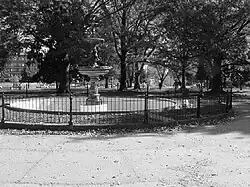| Monroe Park | |
|---|---|
 Monroe Park facing east | |
| Type | Public Park |
| Location | Richmond, Virginia |
| Coordinates | 37°32′48″N 77°27′01″W / 37.5465354°N 77.4502613°W[1] |
| Created | 1851 |
| Operated by | City of Richmond |
| Website | monroepark.com |
| Built | 1851 |
| Part of | Monroe Park Historic District (ID84003572) |
| Designated CP | July 05, 1984[2] |
Monroe Park is a 7.5 acres (3.0 ha) landscaped park 1 mile (1.6 km) northwest of the Virginia State Capitol Building in Richmond, Virginia. It is named after James Monroe, the fifth president of the United States (1817–1825). The park unofficially demarcates the eastern point of the Fan District and is Richmond's oldest park.[3] It occupies the center of the Virginia Commonwealth University Monroe Park Campus.
Description
Monroe Park is pentagonal in shape, with an arrangement of paved paths among lawns and mature deciduous trees, intersecting at a cast iron fountain in the center of the area. This Victorian park is currently in the planning process of a historically sensitive, extensive renovation.[3] The Monroe Park Advisory Council, an organization constituted by Richmond City Councilman William Pantele in 2003, in partnership with the Richmond Department of Parks, Recreation and Community Facilities and Richmond's Department of Community Development are leading the renovation initiative.
Features
.jpg.webp)
A bronze statue of Williams Carter Wickham designed by Edward Virginius Valentine was erected in the Park in 1891.[4][5] The work was the gift of Williams' fellow soldiers and the employees of the Chesapeake and Ohio Railway.[6]
In 2017, Clayton and Will Wickham, two of Wickham's descendants, requested that the city of Richmond remove the statue.[7][8] In their letter to the city council, the brothers wrote that "as a plantation owner, Confederate general and industrialist, General Wickham unapologetically accrued power and wealth through the exploitation of enslaved people".[7]
Public objections to the sculpture's presence in Monroe Park increased during the 2020 George Floyd protests. In June 2020, protesters toppled the sculpture using ropes.[9][10][11]
History
The land on which the Park is located was purchased by the City of Richmond in 1851[12] at the cost of $13,592.56.[13] Originally, the land was used as the State Agricultural Fair Grounds in the mid-19th century. During the American Civil War the area was used as a military camp and military hospital. A central stone fountain was donated by U.S. Army Lieutenant Colonel Albert Ordway in 1872.[14] It was later replaced with the current cast iron fountain in the early twentieth century. Monroe Park was home to the City's first baseball games.[15]
References
 Media related to Monroe Park (Richmond, Virginia) at Wikimedia Commons
Media related to Monroe Park (Richmond, Virginia) at Wikimedia Commons
- ↑ "Monroe Park". Geographic Names Information System. United States Geological Survey, United States Department of the Interior.
- ↑ "National Register Information System". National Register of Historic Places. National Park Service. March 13, 2009.
- 1 2 "Site History" (PDF). Monroe Park Conservancy. Retrieved September 21, 2016.
- ↑ "Williams Carter Wickham, (sculpture)". Smithsonian Institution. Retrieved July 2, 2020.
- ↑ Sedore, Timothy S. (2011). An Illustrated Guide to Virginia's Confederate Monuments. SIU Press. ISBN 9780809386253 – via Google Books.
- ↑ Layton, Robert C. (2013). Discovering Richmond Monuments: A History of River City Landmarks Beyond the Avenue. Arcadia Publishing. ISBN 9781614239529 – via Google Books.
- 1 2 ROBINSON, MARK. "Confederate descendants ask Richmond Mayor to remove statue from Monroe Park". Richmond Times-Dispatch.
- ↑ "Descendants of Confederate general seek statue's removal". WSET. Associated Press. August 31, 2017.
- ↑ Rahman, Khaleda (June 7, 2020). "Confederate Leader Williams Carter Wickham Statue in Virginia Capital Torn Down, Graffitied Overnight". Newsweek. Retrieved June 6, 2020.
- ↑ Fultz, Matthew (June 7, 2020). "Crew heard cheers as Confederate general's statue toppled in Monroe Park". WTVR-TV.
- ↑ GORMAN, SEAN; MORENO, SABRINA. "WATCH NOW: Confederate statue removed from Monroe Park after protesters tore it down Saturday night". Richmond Times-Dispatch.
- ↑ "Monroe Park Historic District National Register Nomination" (PDF). Virginia Department of Historic Resources. Archived from the original (PDF) on June 30, 2021. Retrieved November 18, 2023.
- ↑ Clinger, David (1998). The Ghosts and Glories of Monroe Park: A Sesquicentennial History. Richmond, Virginia: The Dietz Press. p. 3. ISBN 0-87517-102-8.
- ↑ Clinger, David (1998). The Ghosts and Glories of Monroe Park: A Sesquicentennial History. Richmond, Virginia: The Dietz Press. p. 13. ISBN 0-87517-102-8.
- ↑ "Monroe Park SA-67 | Marker History". Archived from the original on November 17, 2011.

